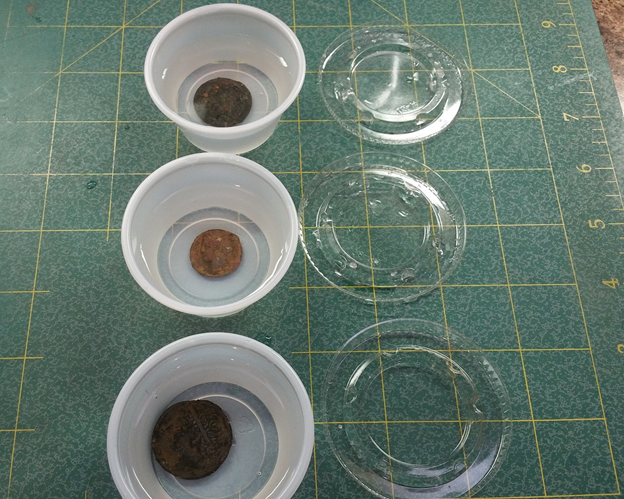The correct way to make 5% solution of sodium sesquicarbonate for bronze disease treatment
Also see:
Bronze Disease
I bought a group lot lately with a couple of nice bronzes that turned out to be infected with serious bronze disease. (I know it is not a "real" disease, but this is the name ancient collectors use for this condition). Looking up the directions for making sodium sesquicarbonate on the internet I found that many of the directions were not correct and would result in a solution that was 3x too strong. There are apparently a lot of copies of an incorrect article on how to make a 5% solution of sodium sesquicarbonate floating around, that continue to propagate through the magic of cut and paste.
I put this tutorial together to help people to make a 5% solution the correct way, that is the main thing I am trying to accomplish, not describe or debate all the ways there are to treat bronze disease (BD). I am no an expert when it comes to fighting bronze disease, from my research, this seems like an accepted way to treat serious infections.
A relatively safe way to treat serious BD in ancient coins is to physically remove the visible fluffy green bronze disease using brushes, toothpicks, etc. and soak them in a 5% solution of sodium sesquicarbonate for weeks to months, changing the solution every week. I like to let the coins dry out each week and check them, repeating the picking off the visible BD if needed. More BD keeps coming in bad cases for weeks to months.
Preparing the Solution
To make the solution start with: distilled water (yes, I know some people think city water is fine but I prefer to start with water with no chlorine or other unknown compounds in it), a measuring vessel graduated in milliliters, a small cup, a gram scale ($20 on eBay or Amazon), and sodium sesquicarbonate powder (available on eBay for a $5 a pound). Sodium sesquicarbonate is considered a safe chemical and is used in cosmetics.
Start by weighing your small, dry cup, I used a soy sauce cup from the local Thai place. Keep these and their lids because they are useful for this treatment. Notice the cup weighs 2.2 grams. Your cup will likely have a different weight.
Add sodium sesquicarbonate powder to the cup until you have added 5 grams. Notice the scale reads 7.2 grams now. You will need to adjust to account for your cup 's weight and add it to the 5 grams. [If you have a 'TARE ' button, you can reset the scale to 0 grams by pressing it while the cup is on the scale.]
Pour the powder into the measuring vessel.
Add distilled water until it reaches 100 millimeters. Water weighs 1
gram per milliliter. So, you have added 95 grams of water to 5 grams of
sodium sesquicarbonate powder yielding a 5% solution. Stir until the
powder is all dissolved. The solution will turn clear when all the
powder is dissolved.
Treating Coins with the Solution
Physically remove the visible fluffy green bronze disease using brushes, toothpicks, etc. Bronze disease is soft and comes off easily but can be difficult to remove entirely from some areas such as deep pits. Don 't destroy the coin trying to remove it.
Soak the coins for in acetone 10 minutes to remove wax, varnish,
etc. before starting the procedure. This allows the bases in the
solution to reach the chlorine ions in the BD and react with them.
Do not boil the coins in this solution (as some recommend) unless you want the patina stripped off.
I like to treat coins in individual cups. The sodium solution is a
conductor, allowing differences in the alloys of the coins to set up
electrical currents causing unknown but usually undesired electrolysis
actions on the coins. The soy sauce containers are perfect for holding
most coins.
It is important to cover the cups to prevent the water from evaporating. If the water evaporates, the sodium is left behind, and the concentration of the solution goes up. A concentrated enough solution can remove the patina completely from bronze coins (this has happened to me). I have found that even 5% is enough to affect the patina on some coins. You can top up the water in cups periodically with distilled water if you notice it evaporating.
Remove the coins from the solution and let them dry out each week and check them, repeating the
picking off the visible BD if needed. In bad cases, more BD will keep coming for weeks to months.
Repeat the treatment using fresh solution every week. Repeat until the solution remains clear after a week of soaking and no BD returns after the coin drys.
Sometimes this treatment takes months to be successful, and sometimes if
the BD is deep inside the coin then it still does not work. This works
best for surface infections.
Hope this has been useful.
- Theodosius|






